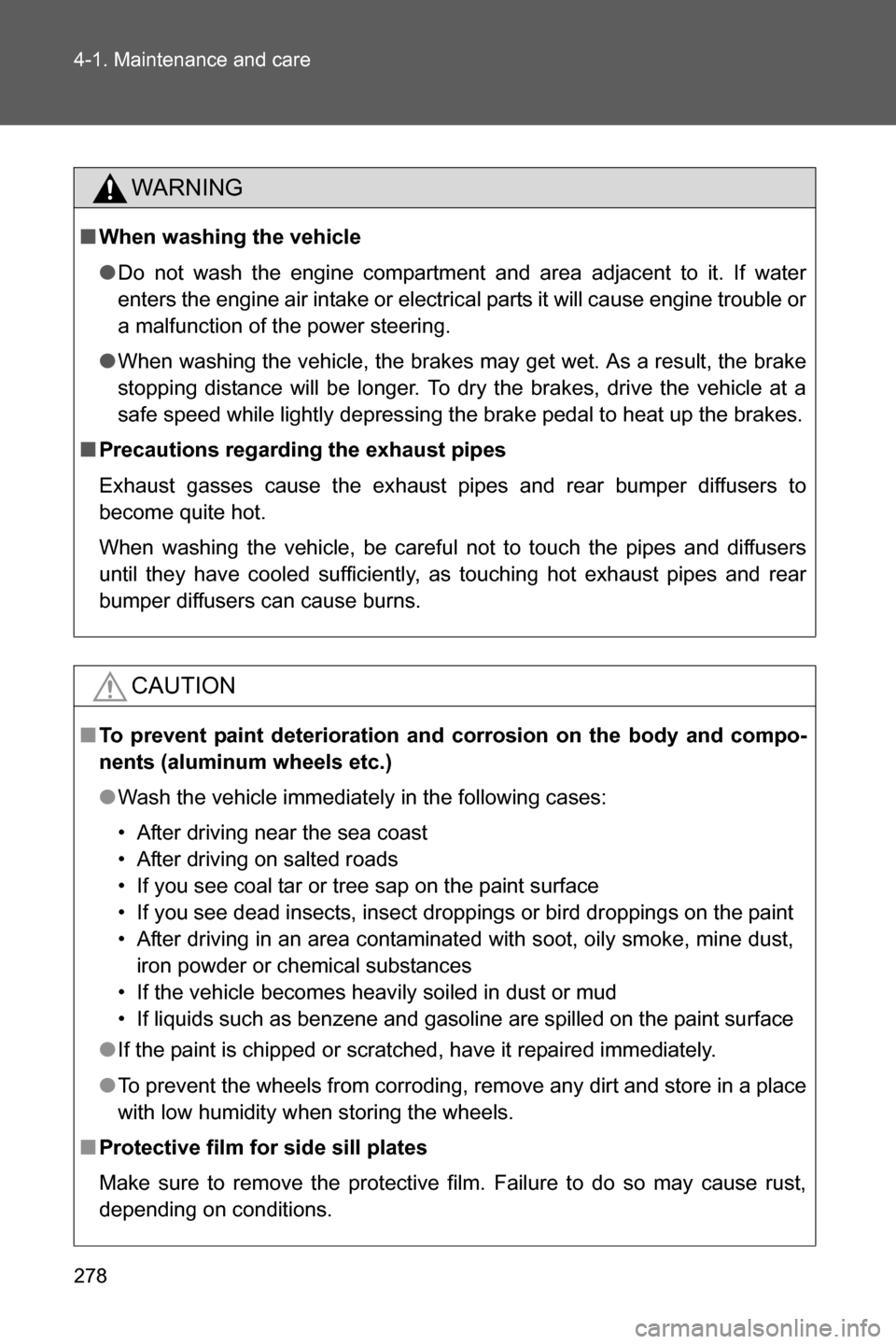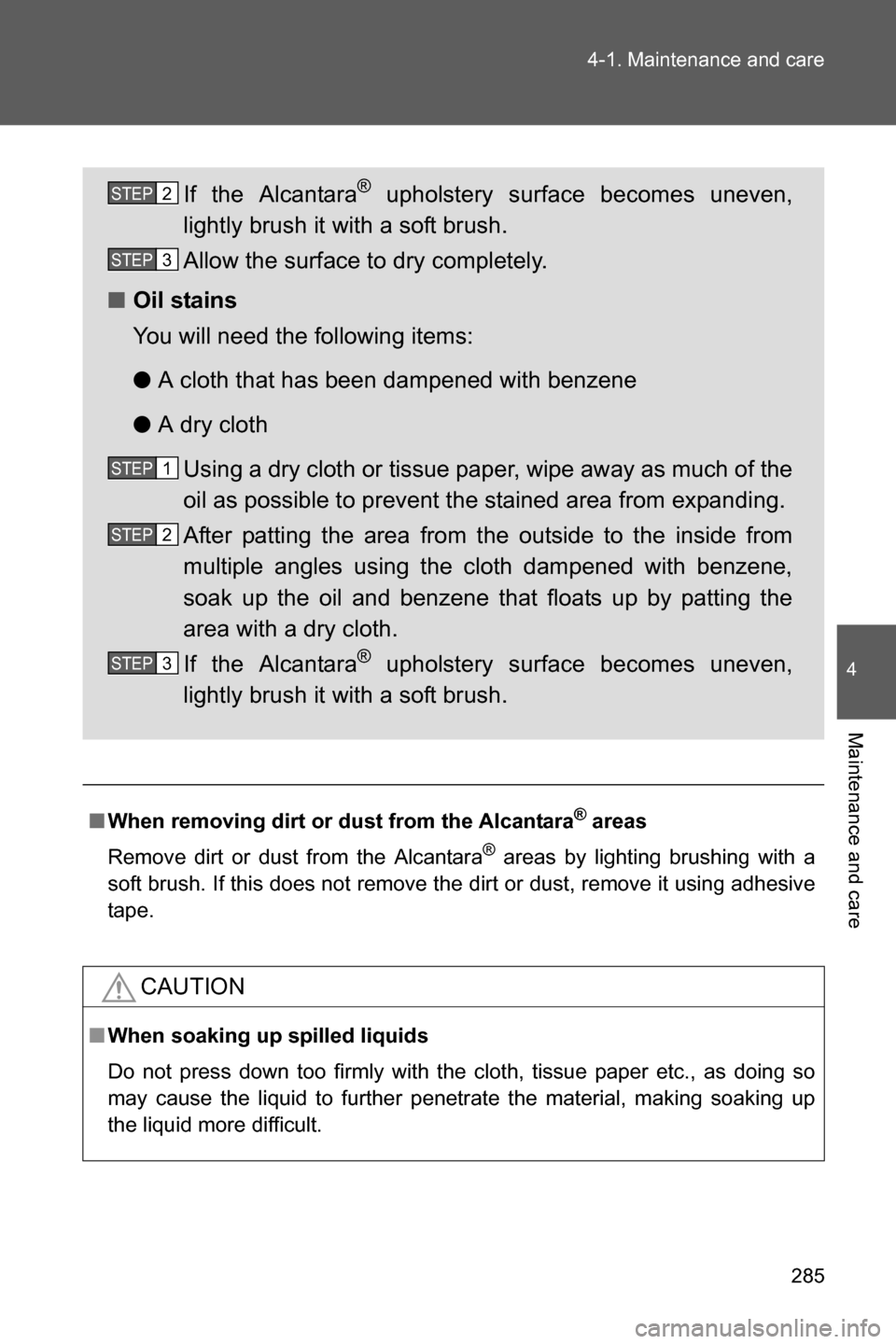Page 276 of 490
Maintenance and care4
275
4-1. Maintenance and care
Cleaning and protecting
the vehicle exterior......... 276
Cleaning and protecting
the vehicle interior.......... 280
Cleaning and protecting
the Alcantara
® area ....... 284
4-2. Maintenance
Maintenance
requirements .................. 286
General maintenance....... 289
Emission inspection and
maintenance (I/M)
programs........................ 2924-3. Do-it-yourself
maintenance
Do-it-yourself service
precautions .................... 293
Engine hood ..................... 296
Engine compartment ........ 298
Tires ................................. 312
Tire inflation pressure ...... 319
Wheels ............................. 323
Air conditioning filter......... 326
Transmitter/access key
battery ............................ 329
Checking and replacing
fuses .............................. 334
Light bulbs........................ 342
Page 279 of 490

278 4-1. Maintenance and care
WARNING
■When washing the vehicle
●Do not wash the engine compartment and area adjacent to it. If water
enters the engine air intake or electrical parts it will cause engine trouble or
a malfunction of the power steering.
●When washing the vehicle, the brakes may get wet. As a result, the brake
stopping distance will be longer. To dry the brakes, drive the vehicle at a
safe speed while lightly depressing the brake pedal to heat up the brakes.
■Precautions regarding the exhaust pipes
Exhaust gasses cause the exhaust pipes and rear bumper diffusers to
become quite hot.
When washing the vehicle, be careful not to touch the pipes and diffusers
until they have cooled sufficiently, as touching hot exhaust pipes and rear
bumper diffusers can cause burns.
CAUTION
■To prevent paint deterioration and corrosion on the body and compo-
nents (aluminum wheels etc.)
●Wash the vehicle immediately in the following cases:
• After driving near the sea coast
• After driving on salted roads
• If you see coal tar or tree sap on the paint surface
• If you see dead insects, insect droppings or bird droppings on the paint
• After driving in an area contaminated with soot, oily smoke, mine dust,
iron powder or chemical substances
• If the vehicle becomes heavily soiled in dust or mud
• If liquids such as benzene and gasoline are spilled on the paint surface
●If the paint is chipped or scratched, have it repaired immediately.
●To prevent the wheels from corroding, remove any dirt and store in a place
with low humidity when storing the wheels.
■Protective film for side sill plates
Make sure to remove the protective film. Failure to do so may cause rust,
depending on conditions.
Page 280 of 490
279 4-1. Maintenance and care
4
Maintenance and care
CAUTION
■Cleaning the exterior lights
●Wash carefully. Do not use organic substances or scrub with a hard brush.
This may damage the surfaces of the lights.
●Do not apply wax on the surfaces of the lights.
Wax may cause damage to the lenses.
■To prevent damage to the windshield wiper arms
When lifting the wiper arms away from the windshield, pull the driver side
wiper arm upward first, and repeat for the passenger side. When returning
the wipers to their original position, do so from the passenger side first.
■When using a high pressure car wash
Do not bring the nozzle tip close to following parts and boots (Rubber or
resin manufactured cover), or connectors. Parts may be damages if they
come into contact with high pressure water.
• Traction related parts
• Steering parts
• Suspension parts
• Brake parts
Page 281 of 490

280
4-1. Maintenance and care
Cleaning and protecting the vehicle interior
The following procedures will help protect your vehicle's interior and
keep it in top condition:
■Protecting the vehicle interior
●Remove dirt and dust using a vacuum cleaner. Wipe dirty sur-
faces with a cloth dampened with lukewarm water.
●When the interior is extremely dirty, wipe away the dirt using a
soft cloth slightly dampened with diluted neutral detergent.
■Cleaning the leather areas
●Remove dirt and dust using a vacuum cleaner.
●Wipe any excess dirt and dust with a soft cloth dampened with
diluted detergent.
Use a diluted water solution of approximately 5% neutral wool
detergent.
●Wring out any excess water from the cloth and thoroughly
wipe off all remaining traces of detergent.
●Wipe the surface with a dry, soft cloth to remove any remain-
ing moisture. Allow the leather to dry in a shaded ventilated
area.
■Cleaning the synthetic leather areas
●Remove loose dirt using a vacuum cleaner.
●Apply a mild soap solution to the synthetic leather.
●Allow the solution to soak in for a few minutes. Remove the
dirt and wipe off the solution with a clean, damp cloth.
Page 283 of 490

282 4-1. Maintenance and care
CAUTION
■Cleaning detergents
●Do not use organic substances such as benzene or gasoline, acidic or
alkaline solutions, dye, bleach or other detergent. Doing so may discolor
the vehicle interior or cause streaks or damage to painted surfaces.
●Do not use polish wax or polish cleaner. The instrument panel's or other
interior part’s painted surface may be damaged.
●Do not use a chemical agent containing silicone (highly-polymerized sili-
con compound) when cleaning any of the electrical appliances such as the
air conditioning, all switches and their surrounding areas.
If silicon (highly-polymerized silicon compound) contacts these compo-
nents, it may cause the electrical appliances to malfunction.
■Preventing damage to leather surfaces
Observe the following precautions to avoid damage to and deterioration of
leather surfaces.
●Remove any dust, dirt, sand, oil spots etc. on leather surfaces immedi-
ately.
●Do not expose the vehicle to direct sunlight for extended periods of time.
Park the vehicle in the shade, especially during summer.
●Do not place items made of vinyl, plastic, or that contain wax on the uphol-
stery, as they may stick to the leather surface if the vehicle interior heats
up significantly.
■Water on the floor
Do not wash the vehicle floor with water.
Vehicle systems such as the audio system may be damaged if water comes
into contact with electrical components under the floor of the vehicle, and
may also cause the body to rust.
Page 285 of 490

284
4-1. Maintenance and care
Cleaning and protecting the Alcantara® area�
�
: If equipped
The following procedures will protect and keep your vehicle’s
Alcantara® upholstery in top condition:
■Day-to-day cleaning
Perform the following procedures regularly (approximately once
a month).
Wipe the entire Alcantara
® area with a soft cloth that has
been dampened with lukewarm water (approximately 104�qF
[40�qC]) and squeezed out.
Do not wipe too hard. Doing so may make the Alcantara® uphol-
stery surface become uneven. Also, only use a clean cloth.
Once dry, brush the area with a soft brush.
■Liquid stains
●If liquid is spilled, lightly pat the area with a tissue paper or
similar to soak up the liquid.
●When mud, coffee, etc., has dried on the Alcantara
® uphol-
stery, remove it by lightly brushing the area with a soft brush
or similar.
We recommend using a vacuum cleaner to clean up the area after
the above has been performed.
When a stain cannot be removed using the above procedures,
remove it by performing the following:
Lightly wipe the stained area from the outside to the inside
from multiple angles with a soft cloth that has been damp-
ened with lukewarm water (approximately 104�qF [40�qC])
and squeezed out.
Do not wipe the area so strongly that it causes the Alcantara®
upholstery surface to become uneven. Also, prepare a clean
cloth, and always use a clean area of the cloth.
STEP 1
STEP 2
STEP 1
Page 286 of 490

285 4-1. Maintenance and care
4
Maintenance and care
■When removing dirt or dust from the Alcantara® areas
Remove dirt or dust from the Alcantara
® areas by lighting brushing with a
soft brush. If this does not remove the dirt or dust, remove it using adhesive
tape.
CAUTION
■When soaking up spilled liquids
Do not press down too firmly with the cloth, tissue paper etc., as doing so
may cause the liquid to further penetrate the material, making soaking up
the liquid more difficult.
If the Alcantara® upholstery surface becomes uneven,
lightly brush it with a soft brush.
Allow the surface to dry completely.
■Oil stains
You will need the following items:
●A cloth that has been dampened with benzene
●A dry cloth
Using a dry cloth or tissue paper, wipe away as much of the
oil as possible to prevent the stained area from expanding.
After patting the area from the outside to the inside from
multiple angles using the cloth dampened with benzene,
soak up the oil and benzene that floats up by patting the
area with a dry cloth.
If the Alcantara
® upholstery surface becomes uneven,
lightly brush it with a soft brush.
STEP 2
STEP 3
STEP 1
STEP 2
STEP 3
Page 289 of 490

288 4-2. Maintenance
WARNING
■If your vehicle is not properly maintained
It could result in serious damage to the vehicle and possible serious injury or
death.
■Warning in handling of battery
●Before beginning work on or near any battery, be sure to extinguish all cig-
arettes, matches, and lighters. Never expose a battery to an open flame or
electric sparks. Batteries give off a gas which is highly flammable and
explosive.
●For safety, in case an explosion does occur, wear eye protection or shield
your eyes when working near any battery. Never lean over a battery.
●Do not let battery fluid contact eyes, skin, fabrics, or paint because battery
fluid is a corrosive acid. If battery fluid gets on your skin or in your eyes,
immediately flush the area with water thoroughly. Seek medical help
immediately if acid has entered the eyes.
If battery fluid is accidentally swallowed, immediately drink a large amount
of milk or water, and seek medical attention immediately.
●To lessen the risk of sparks, remove rings, metal watchbands, and other
metal jewelry. Never allow metal tools to contact the positive battery termi-
nal and anything connected to it WHILE you are at the same time in con-
tact with any other metallic portion of the vehicle because a short circuit
will result.
●Keep everyone including children away from the battery.
●Charge the battery in a well ventilated area.
●Battery posts, terminals and related accessories contain lead and lead
compounds, chemicals known to the State of California to cause cancer
and reproductive harm. Batteries also contain other chemicals known to
the State of California to cause cancer. Wash hands after handling.